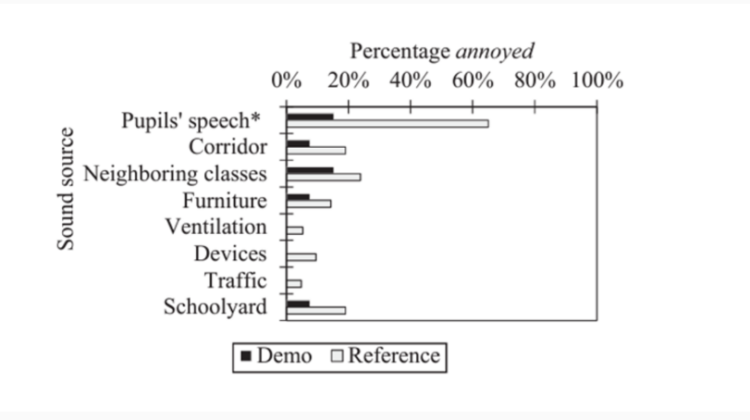

According to the study, additional sound absorbing materials – e.g. acoustic panels, carpets and soft furniture – play a significant role in creating calm and pleasant learning environments.
In a study published in 2023 by Turku University of Applied Sciences. It was found that the noise generated in the school environment from the activities of the class is a significant negative factor. Even if the class meets the Finnish acoustic regulations. Good acoustic design and additional sound absorbing materials were found to reduce both noise generated during operation and its disturbance.
In a study conducted at Loimaa Central School, two classrooms were compared. The standard class (Reference) meeting Finnish acoustic regulations had an acoustic ceiling. The test class (Demo), on the other hand, had both an acoustic ceiling and additional absorbing materials. This included the following materials (e.g. carpet, acoustic panels placed on the wall, curtains and soft furniture).

Also, the general disturbance of the sound was less in the test class than in the standard class
says psychology specialist Jenni Radun from the research group of the built environment of TU Turku.
The most annoying sound source was clearly the students’ speech. This disturbed as many as 65 percent of the students in the standard class. While in the test class only 15% of the students were annoyed by others’ speech.
In a quiet environment, sound levels are up to 13 dB lower

The sound levels during the activity were 2–13 dB lower in the test class than in the standard class. This depended, however, on the type of lesson. Concentrating on teaching, sitting in one’s place and listening to the teacher without seeing his face were rated as easier in the test class than in the standard class.
However, the performance ability of sound absorbing materials alone does not explain the observed decrease in sound level. The calm atmosphere created by the acoustic solutions also affects the students’ behaviour. In the test class, you don’t have to use as loud a voice as in the standard class to be heard, and there is not as much extra noise from the activities.
– Acoustic solutions specifically prevent the emergence of the Lombardi effect, where everyone always has to use more voice to be heard. In teaching spaces, noise always increases noise, and a calm sound environment increases calmness.
says Pauli Pallaskorpi , Concept Developer for learning spaces in Finland with Ecophon who are involved in the research project.
– The additional investment made in the test class is almost negligible compared to the total costs during the life cycle of the building. So the research results should definitely be used in the development of future learning environments.
says Jenni Radun
The study has been published in the international scientific journal Facilities. It is free to download from this link .
Read more about Turku AMK’s news
Previous post about Turku research showing how noise increases stress hormones in blood plasma.

